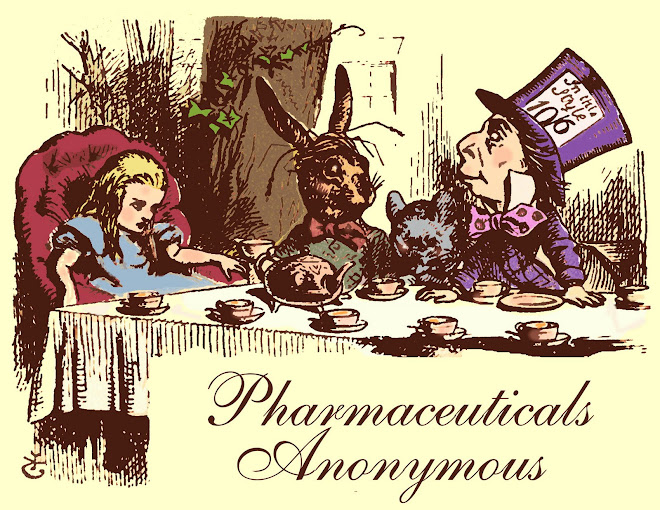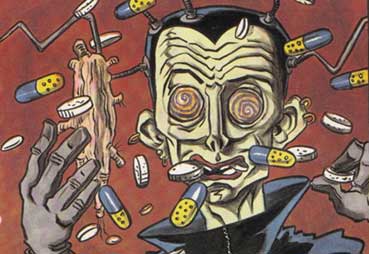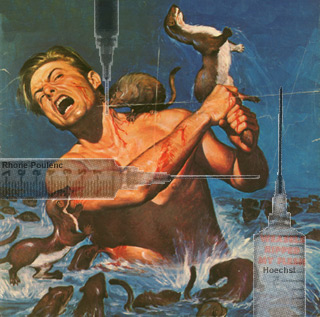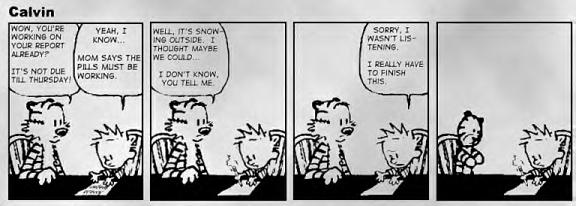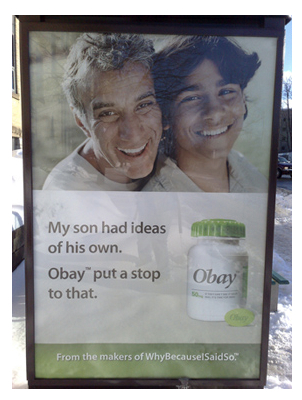
Sunday, March 30, 2008
Saturday, March 29, 2008
"New" "Improved" Antipsychotics Hype
New Schizophrenia drugs no better than the old ones: Reuters
Here you can read about correct diagnosis
and, here, about mental health and vitamins.

Shown: Steven Carter and Abram Hoffer of the International Society of Orthomolecular Medicine
Here you can read about correct diagnosis
and, here, about mental health and vitamins.

Shown: Steven Carter and Abram Hoffer of the International Society of Orthomolecular Medicine
Tuesday, March 25, 2008
Exploring Inner Space: TED and Serenity
"To date, there hasn't been an overarching theory of how the human brain really works, Jeff Hawkins argues in this compelling talk. That's because we still haven't defined intelligence accurately. But one thing's for sure, he says: The brain isn't like a powerful computer processor. It's more like a memory system that records everything we experience and helps us predict, intelligently, what will happen next. Bringing this new brain science to computer devices will enable powerful new applications -- and it will happen sooner than you think."
TED
The next two clips are based on a Josh Whedon film, SERENITY, a cautionary tale set in the future in which mind control through machines and drugs is common. In SERENITY, the population of an entire planet is wiped out because a medication called PAX.. is put in the air supply, for the good of all - they thought. Business and the military no doubt have plans for this technology.
TED
The next two clips are based on a Josh Whedon film, SERENITY, a cautionary tale set in the future in which mind control through machines and drugs is common. In SERENITY, the population of an entire planet is wiped out because a medication called PAX.. is put in the air supply, for the good of all - they thought. Business and the military no doubt have plans for this technology.
From Furious Seasons: Lilly's Zyprexa documents in video form
"The Zyprexa Chronicles: Zyprexa Documents Hit YouTube!
A UCLA PhD candidate in History who's a reader of this site came upon a genius idea: making a video of himself reading one of the Zyprexa documents on YouTube. His name is Brad Fidler (website) and the document he chose (ZY100175096 4.1 MB .pdf) had details of a little role playing game Lilly wanted Zyprexa reps to play in order to increase their knowledge of the drug. The document is quite large, so please use my bandwidth sparingly, and is the primary "Viva Zyprexa" campaign roll out in 2000. The game is called "Family Feud" and is on page 61 of the 67 page document.
Yes, the game sounds weird, but I recall from my own pharma company reppin' days that during sales training reps often acted out various roles--doctor, nurse, purchasing agent, etc.--with one another so we could sell our products better."
And...heeeeere's the game card!

Many thanks to Philip Dawdy at Furious Seasons for bringing this to our attention.
Go see him here
UPDATE: LILLY SETTLED FOR $15M
Pocket change for them
NAMI speaker displays a brain at TED
It's hard to say what is most disturbing in this TED presentation by Jill Bolte Taylor: the disrespectful and manipulative way this NAMI speaker handles and displays a human brain as a prop; the patronizing and stigmatizing use of her brother in her presentation; her ignorance of the 29 physiological reasons why a patient may present as schizophrenic; or her claim that the hemispheres of the brain are completely separate from each other - only briefly mentioning the Corpus Callossum and ignoring the Medulla, Pons, Midbrain, Thalamus and Hypothalamus.
Visit the Harvard Brain Project here.
NAMI associates have been implicated in more than one case of brain theft.
We hope that Dr. Bolte will stop singing long enough to read about the 29 causes of schizophrenia here and here, and we wish appropriate diagnosis, good medical treatment and speedy recovery to her brother.
Sunday, March 23, 2008
Canada's Anti-Drug Strategy for Parents
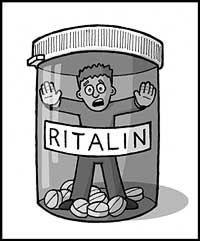
This is all well and good, but the biggest drug dealers are listed on the Stock Exchange.
Why lecture kids about dope when we hand them Ritalin every day?
Have a look at this 2000 BBC report, Kids on Pills
Friday, March 21, 2008
Salon: Doctors Without Orders

Now they want to put dog tags on us to monitor when we take our meds. What next?
Doctors Without Orders
THE MYSTERY OF PATIENTS WHO FAIL TO FOLLOW PRESCRIPTIONS.
By Jessica Wapner
Posted Friday, March 21, 2008, at 10:21 AM ET
Many patients do not take medicine as prescribed
Earlier this month, scientists at Georgia Tech announced their invention of a necklace that records the date and time at which a person swallows his prescription medicine. The device (which looks more like a dog collar than jewelry) responds to a tiny magnet in the pill as it travels down the esophagus. Other recently developed similar technologies include a drug-filled prosthetic tooth that slowly drips medicine into the mouth and a pill bottle that sends a wireless message to your pharmacist every time it's opened.
Are we so bad at taking medicine that we need false teeth to do it for us and pill bottles that tattle on us when we don't?
Wednesday, March 19, 2008
Do SSRI's Cause Lesions in Brains of Elderly?
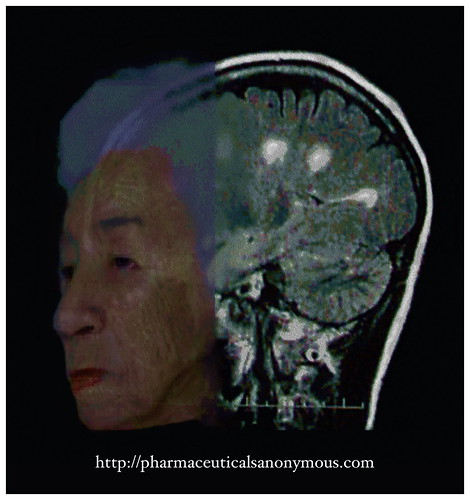
"Antidepressant linked to worsening white matter in elderly
Reuters
Tue, 18 March 2008
The results of a study employing serial cranial MRI suggest that elderly adults who use tricyclic antidepressants may be at increased risk for progression of white matter lesions, which have been linked with late-life depression by previous studies."
Article here
Monday, March 17, 2008
For Anxiety: Try Niacin, not Valium

Image: Edvard Munsch, famous for his painting THE SCREAM, might have had his inner turmoil reduced with nutrition.
Niacin can improve your mood, aid with sobriety, lower cholesterol, heip the heart, reduce arthritis, and add to longevity.
Orthomolcular treatment of anxiety disorders
Dr. Andrew Saul on How to tell if you are getting enough Niacin
Linus Pauling Institute on Niacin
Technical information about Niacin
Our Daily Meds: How the Pharmaceutical Companies Transformed Themselves Into Slick Marketing Machines and Hooked the Nation on Prescription Drugs.

Are Big Pharma murderers?
A New York Times book review focuses on the work of Melody Petersen, a former reporter for the Times. She has written a book against Big Pharma's marketing tactics called Our Daily Meds: How the Pharmaceutical Companies Transformed Themselves Into Slick Marketing Machines and Hooked the Nation on Prescription Drugs. Petersen asks if drugs could be killing people but never being blamed, allowing them to harm even more Americans until someone, finally, catches on. Petersen calls for non-government watchdog agencies and closer oversight on published studies, which she says are ghostwritten by pharma spokespeople.
The review is here
Media Doctor
Alan Cassels takes on the disease mongerers
"Alan Cassels has managed a variety of research and evaluation studies over the past twelve years primarily focusing on the impact of provincial drug benefits policies on consumers. He led the first ever evaluation of Canadian newspaper coverage of new drugs (published in April 2003 in the Canadian Medical Association Journal) and has lectured at Canadian journalism schools on issues surrounding pharmaceutical reporting in Canada. He is currently affiliated with the School of Health Information Sciences at the University of Victoria, and is co-author with Ray Moynihan of "Selling Sickness: How the World's Biggest Pharmaceutical Companies are Turning us all into Patients" (Greystone books, 2005)."
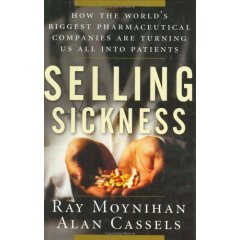
Selling Sickness blog is here
Visit Media Doctor here
"Alan Cassels has managed a variety of research and evaluation studies over the past twelve years primarily focusing on the impact of provincial drug benefits policies on consumers. He led the first ever evaluation of Canadian newspaper coverage of new drugs (published in April 2003 in the Canadian Medical Association Journal) and has lectured at Canadian journalism schools on issues surrounding pharmaceutical reporting in Canada. He is currently affiliated with the School of Health Information Sciences at the University of Victoria, and is co-author with Ray Moynihan of "Selling Sickness: How the World's Biggest Pharmaceutical Companies are Turning us all into Patients" (Greystone books, 2005)."

Selling Sickness blog is here
Visit Media Doctor here
Wednesday, March 12, 2008
Monday, March 10, 2008
Pharmawater: Drugs in the Drinking Water
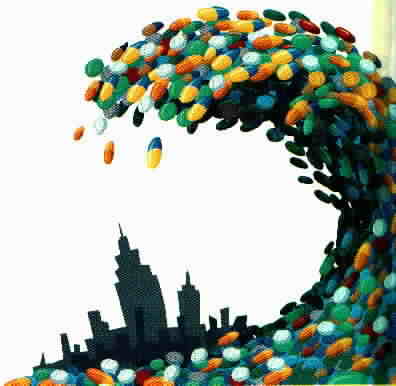
An interactive feature online
Pharmawater from KALB
The US Government suppressed a major public health report. Apparently top officials at the Centers for Disease Control and Prevention thought this was too hot for the public to handle.
Download excerpts from the report
Saturday, March 8, 2008
Rx - A Soap Opera About the Pharmaceutical Industry
Part 1 of 6, so far, with more to come. Adult themes, language advisory.
Friday, March 7, 2008
Stephen Leacock - "The New Food"

Image by Norman Rockwell
The New Food
from Literary Lapses by Stephen Leacock
I see from the current columns of the daily press that
"Professor Plumb, of the University of Chicago, has just
invented a highly concentrated form of food. All the
essential nutritive elements are put together in the form
of pellets, each of which contains from one to two hundred
times as much nourishment as an ounce of an ordinary
article of diet. These pellets, diluted with water, will
form all that is necessary to support life. The professor
looks forward confidently to revolutionizing the present
food system."
Now this kind of thing may be all very well in its way,
but it is going to have its drawbacks as well. In the
bright future anticipated by Professor Plumb, we can
easily imagine such incidents as the following:
The smiling family were gathered round the hospitable
board. The table was plenteously laid with a soup-plate
in front of each beaming child, a bucket of hot water
before the radiant mother, and at the head of the board
the Christmas dinner of the happy home, warmly covered
by a thimble and resting on a poker chip. The expectant
whispers of the little ones were hushed as the father,
rising from his chair, lifted the thimble and disclosed
a small pill of concentrated nourishment on the chip
before him. Christmas turkey, cranberry sauce, plum
pudding, mince pie--it was all there, all jammed into
that little pill and only waiting to expand. Then the
father with deep reverence, and a devout eye alternating
between the pill and heaven, lifted his voice in a
benediction.
At this moment there was an agonized cry from the mother.
"Oh, Henry, quick! Baby has snatched the pill!" It was
too true. Dear little Gustavus Adolphus, the golden-haired
baby boy, had grabbed the whole Christmas dinner off the
poker chip and bolted it. Three hundred and fifty pounds
of concentrated nourishment passed down the oesophagus
of the unthinking child.
"Clap him on the back!" cried the distracted mother.
"Give him water!"
The idea was fatal. The water striking the pill caused
it to expand. There was a dull rumbling sound and then,
with an awful bang, Gustavus Adolphus exploded into
fragments!
And when they gathered the little corpse together, the
baby lips were parted in a lingering smile that could
only be worn by a child who had eaten thirteen Christmas
dinners.
(MORAL: Be careful what you put in your mouth.)
About Stephen Leacock
Pharmaceuticals Anonymous Frogs Poster
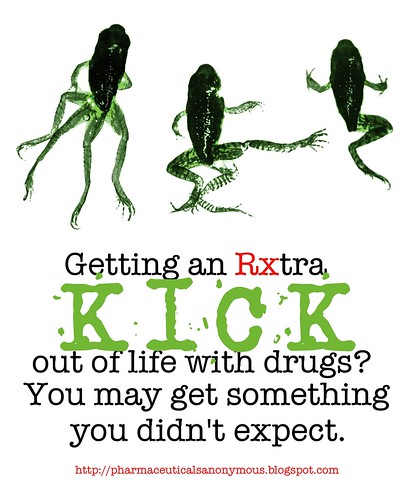
Click on the image to download a free fair-use copy.
Apart from dangers of addiction, dependency, health damage and birth defects which some which some medications present, there are environmental concerns we must address.
Scientific American reports that fish you eat may contain a pharmochemical load sufficient to cause
breast cancer
The very same companies that make medications to treat cancer may be making the chemicals that cause it.
Is Avon's cancer ambassador, Reece Witherspoon, aware of this?
Labels:
avon,
birth defect,
breast cancer,
cancer,
deformity,
drugs,
environment,
frogs,
pharmaceutical industry,
pink ribbon,
pollution,
poster,
reece witherspoon,
teratogens,
water supply
Marketing Overdose Campaign
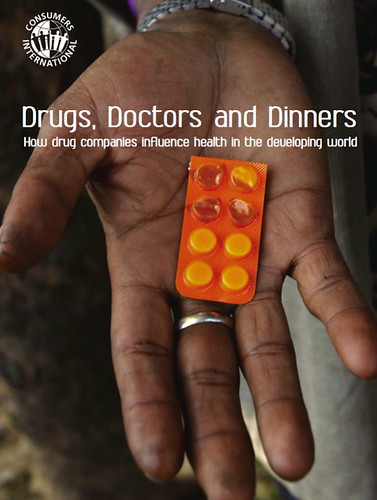
The pharmaceutical industry spends US$60 billion on drugs marketing each year, twice as much as it spends on research and development. Yet consumers know next to nothing about where this money is going. To expose where pharma companies spend this money, how it increases drugs sales, and why this irresponsible behaviour is putting consumer health at risk, Consumers International has produced a series of short, fun films for the Marketing Overdose campaign. Watch them - and get involved.
http://www.marketingoverdose.org/
Don't miss this expose of Pharma manipulation of physicians in Third World countries.
Drugs, Doctors and Dinners
Canada's Dr. Joel Lexchin weighs in on this
in the BMJ
Soft Targets: Nurses and the Pharmaceutical Industry

The pharmaceutical industry recognizes nursing influence on medical prescribing and identifies nurses as a marketing target. The industry has had its eye on nurses and nurse practitioners for over a decade, and is heavily invested in wooing them. The nursing literature has yet to pay much attention to the expansive reach of the pharmaceutical industry into the nursing profession. In this article, some of the key literature on the influence of drug companies upon nurses is examined.
Article here
Thursday, March 6, 2008
Stop the MOTHERS Act - Medicating the Unborn

Illustration of Paxil birth defect.
Read the Bill here
Despite reports that antidepressants - SSRI drugs - have no more therapeutic worth than placebos, Big Pharma is
aggressively promoting a new law in Congress. The MOTHERS law would attempt to prevent postpartum depression by drugging women with antidepressants while they're pregnant. SSRI drugs have never been approved for use on newborns, yet this Act will drug the unborn and newborns with antidepressants. What effect will this have on their brains? Will they grow up to be school shooters, prone to violent thoughts and behavior? Will they kill themselves in childhood? And what will the effect of loss of freedom and these medications be on the mother?
The Pharmaceutical Drug Racket
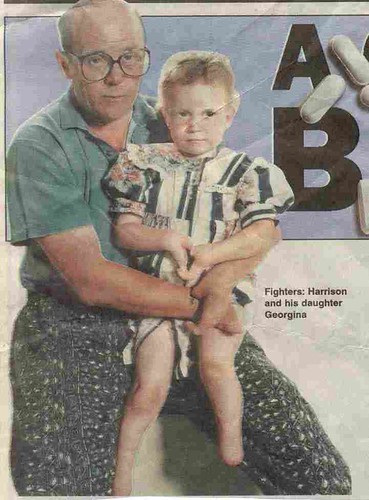
Image - Thalidomide deformities passed along to the next generation.
Substances that cause birth defects are called Teratogens.
Part 1
"One result of the vast over-consumption of drugs is the astronomical profits generated by the drug industry. Since the beginning of the sixties, drug industry profits (as a percentage of sales and company net worth) have surpassed all other manufacturing industries listed on the Stock Exchange. (20)
Another result is the inevitable deterioration of public health. According to the Food and Drug Administration (FDA), 1.5 million Americans were hospitalised in 1978 as a consequence of taking drugs and some 30 per cent of all hospitalised people are further damaged by their treatments. Every year, an estimated 140,000 Americans are killed because of drug taking (21) and one in seven hospital beds is taken up by patients suffering from adverse drug reactions. (22)
A report by the General Accounting Office in the United States revealed that 51.5 per cent of all drugs introduced between 1976 and 1985 had to be relabelled because of serious adverse reactions found after the marketing of these drugs. These included heart, liver and kidney failure, foetal toxicity and birth defects, severe blood disorders, respiratory arrest, seizures and blindness. The changes to the labelling either restricted a drug's use or added major warnings. (23)
HOW COMMON ARE DRUG ADVERSE REACTIONS?
According to the Adverse Drug Reactions Advisory Committee (ADRAC), the official federal government body responsible for monitoring the safety of drugs already in use: "There is a dearth [scarcity] of published information on the medical and economic importance of adverse drug reactions in Australia." (24) However, a recent study (1991), cited by the National Health Strategy report on drug use, claims that in 1987-88 there were between 30,000 and 40,000 hospital admissions in Australia because of drug taking and also that adverse drug reactions (ADRs) would have been a major factor for between 700 to 900 deaths a year. (25)
There are some who are highly critical of the official estimation of the extent of drug reactions within communities. Dr Julian Gold, head of the National Health Surveillance Unit of the Commonwealth Institute of Health, whose job as a medical epidemiologist is to collate information on the total health environment, estimates that up to 40 per cent of all patients in Australia may actually be victims of doctor induced (iatrogenic) illnesses. (26) A 40 per cent figure has also been estimated for the United Kingdom. (27) Generally of this amount, half are from drug reactions. (28)"
Part 2
"SOME FRAUDULENTLY TESTED DRUGS THAT INJURED AND KILLED
Paracetamol (painkiller) - 1,500 people had to be hospitalised in Great Britain in 1971.
Orabilex - caused kidney damages with fatal outcome.
MEL/29 (anti-hypertensive) - caused cataracts.
Methaqualone (hypnotic) - caused severe psychic disturbances leading to at least 366 deaths, mainly through murder or suicide.
Thalidomide (tranquilliser) - caused 10,000 malformed children.
Isoproterenol (asthma) - caused 3,500 deaths in the sixties.
Stilboestrol (prostate cancer) - caused cancer in young women.
Trilergan (anti-allergic) - caused viral hepatitis.
Flamamil (rheumatism) - caused loss of consciousness.
Eraldin (heart medication) - caused severe eye and digestive tract damage, and many deaths.
Phenformin (diabetes) - caused 1,000 deaths annually until withdrawn.
Atromid S (cholesterol) - caused deaths from cancer, liver, gall bladder and intestinal disease.
Valium (tranquilliser) - addictive in moderate doses.
Preludin & Maxiton (diet pills) - caused serious damage to the heart and the nervous system.
Nembutal (insomnia) - caused insomnia.
Pronap & Plaxin (tranquillisers) - killed many babies.
Phenacetin (painkiller) - caused severe damages to kidneys and red blood corpuscles.
Amydopyrine (pain killer) - caused blood disease.
Marzine (nausea) - damaged children.
Reserpine (anti-hypertensive) - increased risks of cancer of the brain, pancreas, uterus, ovaries, skin and women's breasts.
Methotrexate (leukaemia) - caused intestinal haemorrhage, severe anaemia and tumours.
Urethane (leukaemia) - caused cancer of liver, lungs and bone marrow.
Mitotane (leukaemia) - caused kidney damage.
Cyclophosphamide (cancer) - caused liver and lung damage.
Isoniazid (tuberculosis) - caused liver destruction.
Kanamycin (tuberculosis) - caused deafness and kidney destruction.
Chloromycetin (typhoid) - caused leukaemia, cardiovascular collapse and death.
Phenolphthalein (laxative) - caused kidney damage, delirium and death.
Clioquinol (diarrhoea) - caused blindness, paralysis and death.
DES (prevent miscarriage) - caused birth defects and cancer.
Debendox (nausea) - caused birth defects.
Accutane (acne) - caused birth defects.
Kanamycin (tuberculosis) - caused deafness and kidney destruction."
Asylum Song
Footage from the inside and the outside of Northampton State Hospital.
"Follow me here..." 1856.org, Anna Schuleit's Northampton State Hospital project
Canada: $110 Million for a STUDY on the Homeless
$110,000,000 will pass from one branch of the government to a sub-branch which answers to no one.
$110,000,000 - not for housing, or medical care, or clothing, or food... for a study.
Which does not know how to find its subjects and does not seem to have a methodology.
link
$110,000,000 - not for housing, or medical care, or clothing, or food... for a study.
Which does not know how to find its subjects and does not seem to have a methodology.
link
Naomi Klein: The Commericalization of War - and mental health care
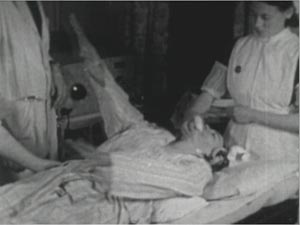
Image of electroshock (ECT) treatment from the 1950's. A single ECT treatment lasting seconds may give a doctor a fee over a thousand dollars - and leave the patient with permanent intellectual damage.
Naomi Klein video at The Guardian
The Shock Doctrine. When we or family members are ill, we may be misled, take bad advice and pay more for treatments than we would if we were well-informed.
Dubai may not save Sir Win Bischoff's CitiBank
Wednesday, March 5, 2008
Wellstone Bill Passes: More Money for Meds

Wellstone bill passed
The mental health industry will claim this will mean better care; it certainly will mean more money for pharmaceuticals. As VeraCare/AHRP notes, much of what passes for care is merely
a front for pharmaceutical interests.
Wellstone, a famous "friend" of NAMI, was no saint, no champion of the little guy; the four workers on his ill-fated flight were illegally uninsured.
Sunday, March 2, 2008
Myth of the Antipsychotic
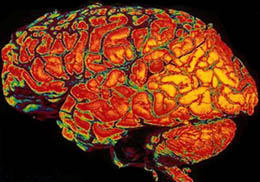
Link
Antipsychotic drugs don't work, are causing a brain damage epidemic and almost triple the risk of dying early, a new book claims. Yet the mental health establishment, as it did with Prozac, is failing to take the evidence seriously.
Historically, whatever dissenters thought has been ignored. So, it appears, have new studies which indicate that antipsychotics do not work long-term. For example, a US study last year in the Journal of Nervous and Mental Disease reported that people diagnosed with schizophrenia and not taking antipsychotics are more likely to recover than those on the drugs. The study was on 145 patients, and researchers reported that, after 15 years, 65% of patients on antipsychotics were psychotic, whereas only 28% of those not on medication were psychotic. A staggering finding, surely? So where were the mainstream media yelps of "breakthrough in schizophrenia treatment". Not a squeak.
Moncrieff's second point is that the psychiatric establishment, underpinned by the pharmaceutical industry, has glossed over studies showing that antipsychotics cause extensive damage - the most startling being permanent brain atrophy (brain damage) or tardive dyskinesia. As in Parkinson's Disease, patients suffer involuntary, repetitive movements, memory loss and behaviour changes. Antipsychotics cause atrophy within a year, Moncrieff says. She accuses her colleagues of risking creating an "epidemic of iatrogenic brain damage".
Moncrieff is a hard-nosed scientist, so she is respectfully reserved. But gross scientific misconduct is her accusation. "It is as if the psychiatric community can not bear to acknowledge its own published findings," she writes.
...
Psychiatrists should be involved in "shared decision-making" with patients, and would have to go to civil courts to argue their case for compulsory treatment. "Psychiatry would be a more modest enterprise," writes Moncrieff, "no longer claiming to be able to alter the underlying course of psychological disturbance, but thereby avoiding some of the damage associated with the untrammelled use of imaginary chemical cures."
The mental health establishment should learn from the Prozac story and pay attention. It's about time.
Subscribe to:
Posts (Atom)
